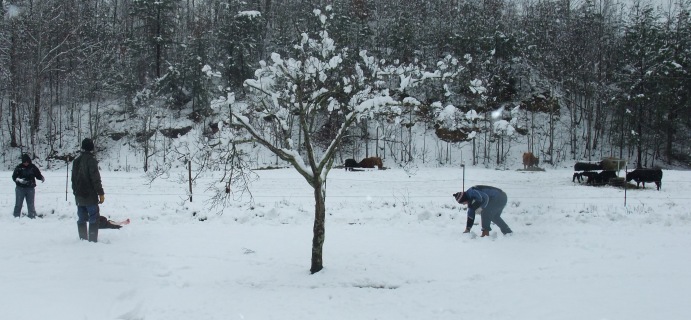Hello, Happy New Year & Welcome to Hope Refuge Farm and our new website! We want this blog to be a place where you can learn what you want to know about keeping a family cow. Not that we’re experts yet, but we have learned an aweful lot over the almost 3 years that we’ve owned cows. We invite you to come learn with us!
As winter really sets in here, each day is hay, hay & MORE hay! But now, with the holidays behind us, people start thinking ahead to spring – and buying that cow they’ve been wanting to provide dairy products for their family. Oh, the joys of cow-shopping! But before you get too caught up in the excitement of all the pretty girls, there are some other things to think about. A lot of things, actually, so I’m going to post this month in three installments – here’s chapter 1.

Family Milk Cow 101: So You Want To Buy A Cow?
There are many things to consider before buying your first family milk cow. When we bought our first cow, we were really only about halfway ready, but we jumped in anyway… and learned a lot of things the hard way. Things probably would have gone easier if we had had a clear plan & finished facilities BEFORE we brought home our beautiful bovine. So here are some questions & ideas to get you started on your way to being a milk cow owner.
Chapter 1: Facilities
It may not be the most interesting aspect of getting a cow, but it’s what you have in front of you now, and it’s where you need to start. Milking out in the rain in the pasture because you don’t have a barn to milk in isn’t fun (yes, I know this from experience). So here are some things to look at.
Pasture:
How much pasture do you have and what condition is it in? This will determine how many animals your land can support. Do you have a plan for maintaining pasture fertility & productivity? Using a system such as rotational grazing gives paddocks a chance to recover & prevents overgrazing. But you also need to decide how you’ll get necessary nutrients into your soil. Do you have a dependable water source? Tanks need to be kept filled (and thawed in winter), pond/creek edges can turn into a mess. Is your fencing adequate? Cattle panels, barbed wire or electric can work, it just has to keep in mature adults & those wee bitty calves. If you want to use rotational grazing, have your paddock fencing done from the start, or it may end up being one of those unfinished projects!
Barn/Shelter:
Although some breeds of cattle are quite hardy, they still will need shelter from the extremes of weather. Do you have a safe, sturdy structure large enough for the animals you intend to have? And how will you manage manure in said building? Will you need hay storage? Do you have a large, safe stall for calving in cold weather? Will you be able to separate cow & calf so there’s milk for you? Separate stalls or small corrals are nice because cow & calf have the comfort of seeing each other & being close, but baby can’t nurse. (more about this later)
Milking:
Where will you do your milking? Milking by hand in the pasture with a very docile cow may seem convenient…until it’s pouring rain, or 10 degrees out. You’ll really want a CLEAN, protected area to milk, with running water to clean mud & manure off of udders. How will you milk? Hand milking certainly saves expense on equipment, but it takes longer & increases your chances of contaminating your milk. Have all the equipment you’ll need on hand ahead of time, including filters, disinfectant teat wipes, cleaning brushes and milk storage containers. Keep in mind that all equipment needs to be sanitized, especially if you’re planning to use the milk raw.

This is going to be great! I can’t wait to read the next installments–and to see your set-up first-hand when we come to get Sara.
LikeLike
Good information here. I enjoyed reading this and can’t wait for more. Keep up the good work.
LikeLike